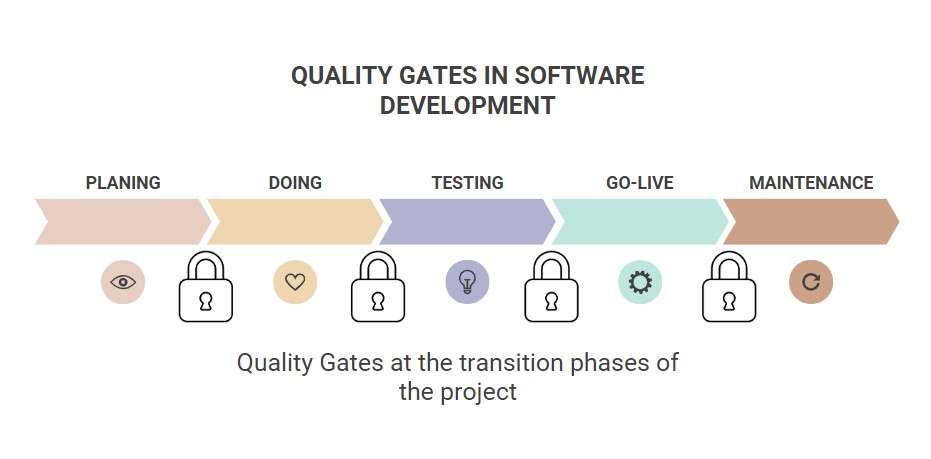Quality Gates are the last line of defense in the project management process. They are checkpoints that determine whether a project can proceed to the next phase of development, and serve as a crucial quality assurance measure. Understanding what Quality Gates are and how to use them is essential for ensuring the delivery of high-quality deliverables.
In this article, we will take a look at the concept of Quality Gates (QGs), explore their advantages and disadvantages, and provide you with practical tips on how to effectively implement them in your project management process. By the end of this guide, you will have a comprehensive understanding of Quality Gates and their significance in delivering top-notch deliverables.
So what are Quality Gates?
Quality Gates serve as predefined benchmarks or conditions that a project must satisfy before advancing to subsequent stages. Acting as pivotal checkpoints, they guarantee adherence to predetermined quality benchmarks, facilitating the seamless transition of the project to its next phase. These gates are strategically positioned at crucial junctures throughout the project’s lifecycle, spanning from initial requirements gathering to design, implementation, testing, and deployment. Each milestone delineates specific criteria and deliverables against which the project’s progress is evaluated, determining its compliance with established quality standards. The overarching aim of Quality Gates transcends the realm of software development alone – it extends to all facets of project management. By mitigating the risks associated with delivering subpar outcomes or defective products, they ensure alignment with user needs and expectations, thereby bolstering overall project success.
In a hurry? Jump to:
Pros and cons of Quality Gates
Quality Gates offer a range of benefits, but also come with some challenges and potential drawbacks. Let’s take a closer look at the pros and cons of Quality Gates to help you make an informed decision on whether to implement them in your project management process.
The Pros
- Enhanced Project Quality: Arguably the foremost benefit of QGs is the elevation of project quality they facilitate. By establishing transparent criteria and deliverables at each project phase and conducting thorough evaluations, Quality Gates engender a culture of quality consciousness. This proactive approach aids in identifying and remedying quality issues early in the project lifecycle, resulting in the delivery of superior project outcomes characterized by reliability and precision.
- Timely Issue Identification: Quality Gates serve as early warning systems, enabling the timely detection and resolution of issues and defects. Through meticulous evaluations and reviews at predefined intervals, they expedite the discovery and rectification of discrepancies. Whether addressing technical complexities, functional inconsistencies, or deviations from project requirements, Quality Gates empower project teams to take prompt corrective action, thereby minimizing disruptions and optimizing project efficiency.
- Effective Risk Management: Quality Gates emerge as stalwart guardians in the realm of risk management. By conducting comprehensive evaluations and reviews, they facilitate the early identification and mitigation of risks. This encompasses technical risks such as compatibility or performance issues, as well as broader project management risks like schedule or budget overruns.
- Clarity in Milestones and Deliverables: QGs establish clear milestones and deliverables for each phase of the project lifecycle. This fosters a shared understanding among project teams and stakeholders regarding project expectations and objectives. The delineation of precise criteria and deliverables simplifies progress monitoring, facilitates project status tracking, and empowers informed decision-making regarding project advancement.
- Stakeholder Alignment: Quality Gates play a pivotal role in ensuring alignment with stakeholder needs and expectations. By defining unambiguous criteria and deliverables, they serve as litmus tests for project compliance with specified requirements. This validation process instills confidence and trust among stakeholders, fostering a collaborative atmosphere conducive to project success.
- Control and Governance: Quality Gates serve as guardians of project control and governance, enabling project managers and stakeholders to steer projects with precision. By providing mechanisms for progress monitoring and decision-making, they ensure project adherence to established plans and objectives. Moreover, Quality Gates facilitate timely issue identification and resolution, contributing to the effective management of project dynamics.
Read more about why Quality Gates provide the control that an organization’s innovation process requires, to deliver consistent innovative output in this article.
No worries, our team’s here to help, and there’s zero obligation. Reach out today!
The Cons
- Increased Overhead and Time: One of the primary challenges associated with Quality Gates is the potential for heightened overhead and time expenditure in the process. The establishment and adherence to Quality Gates necessitate additional effort and resources for meticulous planning, comprehensive documentation, and rigorous evaluation. This can result in an overall increase in project duration and costs, which may prove impractical or undesirable, particularly in fast-paced or resource-constrained environments.
- Process Rigidity: QGs have the propensity to introduce a degree of process rigidity, particularly when implemented in a rigid and inflexible manner. Such rigidity can impede the development team’s capacity to adapt to evolving requirements or unforeseen circumstances. In certain scenarios, flexibility is imperative to address emergent issues or capitalize on newfound opportunities. Overly stringent Quality Gates risk stifling creativity and innovation while hampering the agility of the development process.
- Subjectivity and Bias: The evaluation of a project (e.g. a software development project) against Quality Gate criteria can be inherently subjective, susceptible to individual biases and interpretations. This subjectivity may engender inconsistency in the evaluation process, fostering disparate opinions regarding the compliance with established standards. It’s essential to establish transparent and objective criteria for Quality Gates, supplemented by adequate training and guidance for evaluators to mitigate the influence of subjectivity and bias.
- Resistance from Teams: The introduction of Quality Gates may encounter resistance from development teams, who may perceive them as an added layer of bureaucratic complexity diminishing their autonomy. It’s crucial to engage development teams in the establishment of Quality Gates and communicate the benefits of their implementation, including enhanced quality and reduced rework.
- Complexity Management: Effectively managing Quality Gates demands meticulous planning and coordination to ensure their efficacy without becoming unduly burdensome. This encompasses delineating clear and attainable criteria for each gate, instituting robust evaluation methodologies, and furnishing requisite resources and support for teams to fulfill criteria. Without adept management, Quality Gates risk becoming convoluted and burdensome, detracting from rather than augmenting the development process.
How to implement Quality Gates: A 10-steps guide
While the specific implementation of Quality Gates may vary depending on the unique characteristics of each project and organization, there are some general best practices that can help ensure their effective implementation. We’ll take you through the key steps to successfully implement QGs in your own projects.
Step 1: Define Clear Objectives
The initial step in implementing Quality Gates is to establish clear objectives. Defining these objectives delineates what you aim to achieve with the Quality Gates, be it enhancing project quality, mitigating risks, or ensuring alignment with stakeholder expectations. Clear objectives serve as guiding principles, informing the establishment and execution of QGs. They provide a benchmark against which the effectiveness of the gates can be measured, facilitating continuous improvement and refinement. Moreover, transparently communicating these objectives fosters alignment among project stakeholders and enhances adaptability to changing project dynamics.
Step 2: Identify Key Milestones
Identifying pivotal milestones in the project lifecycle is essential for the seamless integration of Quality Gates. These milestones serve as the designated checkpoints for applying Quality Gates. In software development, common milestones encompass requirements elicitation, design conceptualization, implementation, testing, and deployment. At each milestone, precise criteria and deliverables are established to gauge project quality and progression.
Step 3: Establish Clear Criteria and Deliverables
Once you’ve pinpointed the key milestones, the subsequent step involves establishing precise criteria and deliverables for each Quality Gate. These criteria should be objective, quantifiable, and unambiguous to ensure unequivocal determination of compliance. For instance, criteria may encompass the fulfillment of specific tasks, attainment of predefined quality benchmarks (e.g., code coverage, defect density), or availability of requisite documentation. Deliverables should manifest as tangible artifacts evidencing project quality and advancement, such as comprehensive design blueprints, meticulously crafted test strategies, or functional software prototypes. By delineating clear criteria and deliverables, you furnish a robust framework for evaluating project progress at each Quality Gate.
Step 4: Conduct Thorough Evaluations
Thorough evaluations constitute a pivotal facet of effective Quality Gates. Establishing robust evaluation methodologies is imperative to ascertain adherence to defined criteria and deliverables. This may necessitate conducting meticulous reviews, comprehensive inspections, or rigorous testing protocols to validate software integrity and alignment with established standards. The evaluation methods must be systematic and rigorous, facilitating the meticulous identification of any issues or defects warranting attention before project advancement to subsequent phases.
Step 5: Involve Stakeholders and Team Members
Involving stakeholders and team members in the implementation of Quality Gates is essential for their success. It is important to communicate the purpose and benefits of QGs to all parties involved, and to gather their input and buy-in. Stakeholders can provide valuable insight into the criteria that are most important to them, helping to ensure that the Quality Gates align with their expectations. Involving team members in the establishment of Quality Gates can help to identify practical challenges and ensure that the criteria are realistic and achievable.
Step 6: Provide Training and Support
Implementing Quality Gates may require a change in the way your team works. Providing training and support to team members on the principles and practices of Quality Gates can help them understand the process and their role in meeting the established criteria. Training can also help to ensure that team members have the necessary skills and knowledge to produce high-quality deliverables.
Step 7: Establish Continuous Improvement
Continuous improvement is a fundamental principle of effective Quality Gates. You should regularly review the effectiveness of the QGs and make adjustments as needed. This may involve gathering feedback from stakeholders and team members, analyzing the results of the evaluations, and identifying areas for improvement. By continuously refining the criteria, evaluation methods, and overall process, you can ensure that the Quality Gates remain relevant and effective in improving the quality of your software.
Step 8: Use Tools and Automation
Utilizing tools and automation can streamline the implementation of Quality Gates and make the process more efficient. There are a variety of tools available that can help manage the criteria, track the progress of the project, and automate the evaluation process. For example, version control systems, continuous integration servers, and code review tools can be used in software development projects to ensure that the software meets certain quality standards and that the established criteria are being met. By leveraging these tools, you can reduce the manual effort involved in implementing Quality Gates and improve the consistency and reliability of your evaluations.
Step 9: Document and Communicate Results
Documentation and communication are key to the successful implementation of Quality Gates. You should clearly document the established criteria, deliverables, and evaluation methods so that they are well-defined and understood by all involved parties. Additionally, it is important to communicate the results of the evaluations to stakeholders and team members. This transparency helps to build trust and confidence in the quality of the software, and allows for timely decision-making on whether the project should proceed to the next phase.
Step 10: Monitor and Track Progress
Monitoring and tracking the progress of the project against the QGs is essential for their effective implementation. You should establish clear processes for monitoring the status of the project and tracking the completion of the criteria and deliverables. This can help to identify issues early and take corrective action as needed. Regular reviews and status updates with the development team and stakeholders can ensure that everyone is aligned and that the project is meeting the requirements of the Quality Gates.
Conclusion: The Power of Quality Gates in Project Management
In conclusion, Quality Gates are a powerful tool for ensuring the quality, manageability, and success of your projects. By establishing clear criteria and deliverables at key milestones, conducting thorough evaluations, and continuously improving the process, you can significantly improve the quality of your deliverables, reduce risks, and ensure that your projects meet the needs and expectations of your stakeholders. While the implementation of Quality Gates may pose some challenges, the benefits they bring in terms of improved quality, early issue detection, stakeholder alignment, and project control make them a valuable asset in the arsenal of any project team.
Tip: Looking for a simple Quality Gates template? The Australian Bureau of Statistics provides one here (Excel in the Download section)




